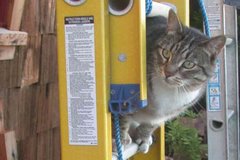We have collected our second core: CAS16-02PC
The official CASEIS Cruise Blog is located here: http://www.ipgp.fr/caseis This official blog is written by my shift-mate Lola Johannes.
Our Second core, CAS16-02PC, arrives on board.
- Today, as I arrived to my shift at 4 AM, Dr. Georgy Ratzov filled Dr. Christian Beck and I in about what we could expect for our shift and what he learned from prior shifts. The second core had just been pulled out of the seafloor and was on its way to the surface, so we had a little time to get ready to process the core. I mentioned the steps in the last blog post here. We would basically prepare, label, and cut the core up to let it sit to later be scanned by the MSCL team.
- Here Dr. Christian Beck awaits the arrival of the core on the ship. He is observing to see if there is sediment on the outside of the core, which would indicate that the core had been embedded in the seafloor. When this core was being pulled out, there was not much tension on the wire (so it was not stuck in the mud with much coupling, unlike the first core).
- Here we can see that the core is on board now. The next step is to rotate the core up to be parallel with the deck and then be placed in the white rollers on the right. Then the core catcher (a device that keeps the sediment in the core when the core is removed from the sea floor) is removed and the white PVC core liner is pulled out of the core barrel.
- Then Dr. Christian Beck (I call him "le chirurgien" (the surgeon) as we cut the liner with a butcher's saw) cuts the top of the core at the top of the sediment. The sediment does not completely fill the liner in most, but not all, cases. Lola Johannes awaits to place a cap on the top of the core.
- Then we clean, dry, and label the core liner. We mark it at 150 cm intervals to guide our surgeon precision cutting. Dr. Beck learned to cut wood from his grandfather who was a carpenter. I get to cut some of the sections and I tell him that it was also my grandfather who was a carpenter as well.
- Here is my entire team. From left to right: Gaelle, Lola Johannes, Chloe Seibert, Marie, Quentin, Christian Beck, and me (Jason Patton) behind the lens. We are cutting the last cut of this core, but not the final cut (which Dr. Beck remarked about the last Pink Floyd album.
- Here is the last section of this core, at the base of the core. These are the typical labels on the side of the core and the end caps. We will then move these core sections into the MST lab to acclimate to the temperature of the instrument
- Here the cores are lined up to be scanned for their geophysical properties.
- This plot of the CHIRP seismic data show the basin in which this second core was collected. There is a pencil line showing the location of the core. The vertical axis is in meters (and is approximate because the depth is calculated with an assumed velocity, which is unknown). We think that the core bottomed out in the dark reflector just above the 5820 depth line (representing a layer with an increased impedance compared to the overlying layer, possibly a thick clay unit).
- In summary, here is a map showing our first two core sites. Our Port of Call, Pointe-a-Pitre is shown on the Island of Guadeloupe (PTP). The two cores are the blue dots labeled 1 and 2. The other dots are potential core locations, with color designating the priority.











No comments:
Post a Comment